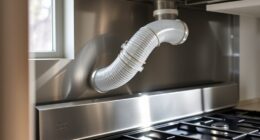Pellet stoves work by burning compressed biomass pellets that are automatically fed from a hopper, with an electronic control system managing the flame and airflow for efficient heating. They provide cleaner, more consistent combustion, producing less ash and emissions than traditional wood stoves. They’re cost-effective, eco-friendly, and easy to install and maintain. To find out why many people consider them a better home heating option, you’ll want to explore more details.
Key Takeaways
- Pellet stoves burn compressed biomass pellets for efficient, clean heating controlled electronically for consistent temperature.
- They are typically more affordable and easier to install than traditional fireplaces or central systems.
- They offer high fuel efficiency, producing minimal ash and emissions, making them environmentally friendly.
- Continuous automatic feeding and programmable thermostats ensure precise, convenient temperature control.
- Overall, pellet stoves are cost-effective, sustainable, and often better for home comfort and eco-friendliness.

Pellet stoves have become a popular alternative to traditional heating options because they offer efficient and environmentally friendly warmth. If you’re considering one, understanding how they work can help you decide if they’re the right choice for your home. The key advantages include high fuel efficiency and relatively manageable installation costs, making them an attractive option for many homeowners.
At their core, pellet stoves burn compressed wood or biomass pellets to generate heat. You load these pellets into a hopper, which feeds them automatically into the burn pot as needed. An electronic control system manages the feed rate and airflow, ensuring consistent combustion. Because the pellets are uniform and dense, they burn more completely than traditional wood, producing more heat with less fuel. This high fuel efficiency not only saves you money but also reduces waste, making pellet stoves a greener heating solution. The combustion process produces minimal ash, simplifying maintenance and helping your home stay cleaner.
Pellet stoves burn uniform, dense pellets for efficient, clean, and cost-effective home heating.
When it comes to installation costs, pellet stoves are generally more affordable than traditional masonry fireplaces or central heating systems. They don’t require extensive venting or chimney work like some other options, which cuts down on installation expenses. Most models can be vented through a wall or roof with minimal modifications, making setup straightforward and quicker. However, you should factor in the cost of the stove itself, which varies depending on size and features, as well as any electrical requirements for the auger and fans. While initial expenses are reasonable, it’s worth considering the ongoing costs of pellets and maintenance, which are typically lower than other heating fuels. Additionally, the use of renewable biomass as fuel reduces reliance on fossil fuels and helps mitigate environmental impacts.
Another benefit that enhances their appeal is the ability to control the heat output precisely. Many pellet stoves come with programmable thermostats, allowing you to set your preferred temperature and maintain a consistent indoor climate. This precision not only boosts comfort but also improves energy efficiency, as you avoid wasting fuel heating an already warm space. Plus, since pellet stoves produce fewer emissions compared to traditional wood stoves, they’re a more eco-friendly choice. The combination of high fuel efficiency, manageable installation costs, and clean operation makes pellet stoves a compelling option for heating your home.
Frequently Asked Questions
Are Pellet Stoves Environmentally Friendly Compared to Traditional Heating?
Yes, pellet stoves are more environmentally friendly than traditional heating because they use renewable energy sources like compressed wood or biomass, which helps reduce your carbon footprint. When you choose a pellet stove, you’re burning a cleaner fuel that produces fewer emissions and less air pollution. This makes pellet stoves a smart, eco-conscious option for heating your home while supporting sustainable energy practices.
How Much Maintenance Do Pellet Stoves Require Annually?
You’ll need to follow a regular maintenance schedule for your pellet stove, cleaning it at least once a week during heavy use. Cleaning requirements include removing ash from the burn pot and vacuuming the interior components to prevent buildup. Annually, you should inspect and clean the venting system and replace any worn parts. Staying consistent with maintenance guarantees your stove runs efficiently and prolongs its lifespan.
Can Pellet Stoves Be Used as the Primary Heat Source?
Yes, you can use a pellet stove as your primary heat source. When considering pellet stove installation, verify it’s suited for your space and properly vented. Pellet stoves offer excellent fuel efficiency, helping you save on heating costs. Regular maintenance keeps them running smoothly, and with proper setup, they can reliably provide consistent warmth throughout the winter. Just make sure to choose the right size and model for your home’s heating needs.
What Is the Typical Lifespan of a Pellet Stove?
You can expect a pellet stove to last around 15 to 20 years with proper maintenance. When considering installation, verify it fits your space and ventilation needs, which can influence lifespan. The cost comparison shows pellet stoves are an affordable long-term option, but quality models with regular upkeep will give you the best durability. Investing in a reputable brand and professional installation helps maximize your stove’s lifespan.
Are Pellet Stoves Safe for Homes With Children or Pets?
Pellet stoves can be safe for homes with children or pets if you take proper precautions. You’ll want to guarantee child safety and pet safety by installing safety barriers or guards around the stove to prevent accidental burns or contact with the hot surfaces. Always supervise when in use, and keep pets and kids away from the stove when it’s operating. Regular maintenance and safety checks also help keep your home secure.
Conclusion
Ultimately, choosing a pellet stove is like planting a seed for warmth and efficiency in your home. It’s a steady flame guiding you through chilly days, offering comfort that grows with each use. While they may not be perfect for everyone, they can become the heart of your cozy sanctuary, turning cold moments into a warm embrace. Embrace the glow, and let your home’s warmth bloom, nourishing both body and soul.










